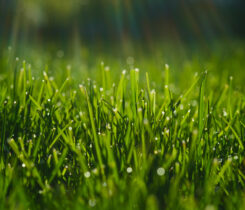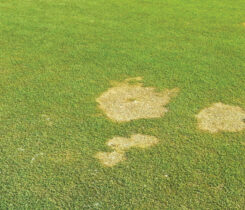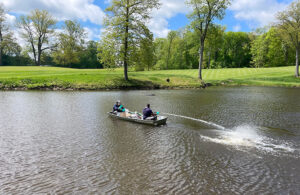Davis Shoots the U.S. Open Breeze
Entering his fourth U.S. Open as the United States Golf Association’s Senior Director of Rules and Competitions, Mike Davis has quickly transitioned the USGA image from staid protectors of par to proponents of interesting, cerebral golf. Davis spoke to Golfdom recently about a range of subjects related to the delicate task of course setup and tournament maintenance.
Q: A year after Torrey Pines, you’ve heard a lot of positive feedback about the setup from players and media. Have you heard of any instances where some of the course setup ideas influenced everyday courses or amateur events?
Davis: I’ve heard several comments about people liking the idea of varying the teeing grounds for everyday play. The one real problem with mixing up teeing grounds seems to unfortunately involve how courses are rated for handicap purposes. Beyond that, I believe people in general like variety. Part of me believes that if golfers were a bit less concerned about their score and more focused on the challenge of each shot, they’d end up enjoying their rounds more.
Q: What has the reaction been from golf course superintendents to the idea of variety in setup?
Davis: At first, I suppose the reactions tended to be, “You’re not seriously thinking of going up there and actually using the forward tee for the U.S. Open?” I also think a few of our host venues wondered if we were going to make the setup too easy. But I think we’ve seen that mixing and matching teeing grounds to certain hole locations or to different drive zones can actually sometimes increase the difficulty because players have to think more. Moving tee markers up also tends to open up more choices of play. I will also say we have been able to use some neat hole locations that we otherwise would have never tried from the championship teeing ground.
Q: Do some people view the varied tee concept as excess, which will only drive up the cost of the game?
Davis: I have not heard that one. I suppose in theory it could actually do the opposite by giving some tees a “rest.”
Q: Would you advocate tiered rough for the everyday course?
Davis: The concept of having less penalty the closer you are to the fairway seems logical, but anything that drives up the cost of course maintenance would not be a good thing. Interestingly at our Opens, it could be argued that the graduated rough might save some manpower and money since less grass gets mowed on a daily basis (i.e., the rough further away from the fairway gets mown less often). I suppose the same could happen for everyday play; mow the closer-in rough at a lower height and a bit more often but let the other rough go for a longer period of time which could save on manpower, equipment wear-and-tear and fuel costs.
Q: When you conjure up various ideas, like varied tees and tiered rough, do you consider the ramifications for the everyday game?
Davis: I’m sorry to say no. It has all been about trying to do the best job possible with the golf course setup. Most of the changes are a result of Jim Hyler (USGA Championship chairman) and me believing we could improve on certain aspects. As an example, I can remember attending the 1980 U.S. Open at Baltusrol Golf Club in Springfield, N.J., when I saw two players in a group miss the fairway to the right of the fifth hole. One player was just barely into the rough and the other guy was 25 or so yards off the fairway. The player close-in took a mighty blow and hit it less than 50 yards, while the other player knocked it to within a foot of the hole after having a fairly simple lie. That incident stuck as an undesirable result. With regard to the ramifications of USGA championship setup on the game, I’ll admit to thinking this probably is not the best message for everyday golf. I’m no fan of playing a course with overly penal rough. I love to play courses with a lot of width. With that said, I would hope that people would rationalize our setup a bit and understand it is one week of the year when the best players encounter tremendously tough playing conditions. In other words, it is a one-off situation meant to be unique.
Q: After the U.S. Open was held at Oakmont Country Club in 2006, you wrote a memo to U.S. Open superintendents about easing back on rough, what was that about?
Davis: The message was about a few things. First, we have seen a gradual thickening of the rough over the last couple decades due in large part to triple-row irrigation. I believe heavier fertilization and over-seeding have also been causes. This has translated into much more severe rough, even when cut at a lower height. Second, we have seen rough become more uniform and consistent so that virtually every lie is the same. Gone are the days of having to look down at a lie and ascertain what the ball will do. We have also seen a trend towards wanting roughs to be only one type of uniform grass in the name of “fairness.” That’s too bad as one of the joys of golf is sizing up a lie and thereafter trying to execute based on that lie. Furthermore, rough that is overly dense also has added to costs — more water, more fertilizer and more mowing — and slower pace of play. None of those things in my mind are good for golf or for our national championships. So in summary, the message was that we are hoping that future venues have roughs that are less thick, less manicured and more inconsistent.
Q: With apologies to the golfers of New York, Bethpage Black seems a bit overrated to me as a design. The greens have little interest, there are no really dramatic risk-reward holes and the finishing hole is downright awful. Tell us what you love about it?
Davis: Well, I value my life so I’ll watch how I answer this one because New Yorkers love their Bethpage! It is true that the putting greens have less pitch and contour than most other U.S. Open venues. However, when they get speedy the movement truly does “come alive.” As far as risk-reward, I’ve been pleasantly surprised after careful study just how many options the players will have. While there is not as much water or other dramatic risk features as some other courses, I think we’ll see plenty of excitement. As for the closing hole, I would agree that it’s not your typical difficult Bethpage Black par 4. It is a relatively short hole with a large green. For that reason, we recontoured the fairway to give the players a choice off the tee and will set it up so birdies are a realistic possibility. It might be easier than the norm, but it also might provide some flare if the championship is on the line.
Q: How do you incorporate weather into your setup plans? We’ve seen a lot of setups go bad in recent years with just the slightest wind or weather event. What do you attribute this to?
Davis: We very carefully monitor the wind (direction and strength), evaporation rates and forecasted precipitation when we’re planning setup for each day. Without a doubt, once you get the course where you want it, it’s all about planning for what Mother Nature sends your way. You must adapt to the changes. As an example, knowing how quickly moisture is evaporating from the ground (and grass) is crucial to managing firmness of the course. Strong winds most definitely affect where tee markers are set, how fast the greens are prepped and where hole locations are set. The scariest part of a U.S. Open setup (which is inherently always close to “the edge”) involves what happens when our meteorologist misses the forecast. I always try to be mindful of that so we incorporate some margin for error. With that said, I unfortunately know that from time to time we will fail.
Q: Does the TruFirm device aid in your preparation work? (Editor’s note: TruFirm, developed by the USGA, is a system that allows the superintendent to measure and analyze the firmness of turf and bunker sands over the course of a tournament.)
Davis: If we’re fortunate enough to have a championship that is dry, water management becomes the most important aspect of course setup. Our scientists who test balls and clubs invented a wonderfully useful course setup device that measure ground firmness. We now measure firmness of putting greens, green approaches and sometime fairways. This allows us to prep the course so there is more consistency. Based on the data, we very carefully work with the grounds staff that hand-waters greens. Some greens might not get any water in the evening or morning; others (or just portions of them) might get a little or a lot. The end result is that, hopefully, there is a good consistency with firmness from green to green. It also helps eliminate over and underwatering when the superintendent sees the data with his own eyes.
Q: Do you think it’s something that will help the everyday course or is more of a device only for major championship setups? Or is it the next Stimpmeter?
Davis: Excellent question – and one we are not sure of yet. The USGA Green Section has discussed this very issue in depth. I think it’s fair to say there are pros and cons to everyday usage. It surely is a fabulous championship setup device and can most definitely help everyday play if used with the proper intent. But some fear that if used improperly it could become a hindrance to the superintendent. With that said, one true benefit beyond firmness consistency would be the potential for less water usage. We all know that issue will be more and more important in years to come.
Q: How do you see the groove rule change playing out and impacting the everyday golf course?
Davis: Initially (from 2010 to 2013), there will be virtually no effect for the everyday golf course since the new groove condition of competition only affects professional golf at the highest level. Most amateur tournaments played at the highest level will adopt the condition in 2014. I think it will have some effect on course set-up at professional tournaments beginning almost immediately next year when players figure out they have less distance control and spin from the rough. They’ll also find they get less spin on pitch shots around the greens. We anticipate that some players may gravitate to a softer, higher-spinning golf ball that may sacrifice some distance. This change should hopefully translate into shorter (and hopefully less dense) rough. While it’s conjecture, I suspect there will be some trickle-down effect from the professional tours to everyday golf. History would show that. We’ll see.












